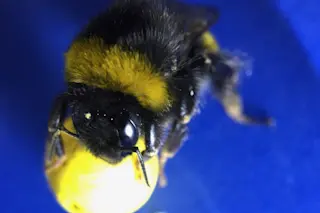A bumble bee hard at work spinning a ball toward its goal. (Credit: Courtesy Clint Perry, Queen Mary University of London)If scoring a goal is the only way to earn a sugary treat, a bumblebee will summon its inner Messi. Indeed, rolling a ball into a goal—soccer, sort of—is the latest puzzle solved by Bombus terrestris
after training with scientists/bee trainers at Queen Mary University of London. In October, scientists from the same lab—the Chittka Lab—taught bees to tug strings for treats. There are no plans to start a traveling carnival; instead, scientists are pushing bees’ to their cognitive limits to learn how complex behaviors arise from minuscule brains.
“There’s no reason to believe that unique capacities of large-brained animals and humans aren’t actually available or present in a lot of other animals,” says Clint Perry, a Queen Mary researcher who studies the power of tiny brains. “Just because a ...














